Physical Address
304 North Cardinal St.
Dorchester Center, MA 02124
Physical Address
304 North Cardinal St.
Dorchester Center, MA 02124
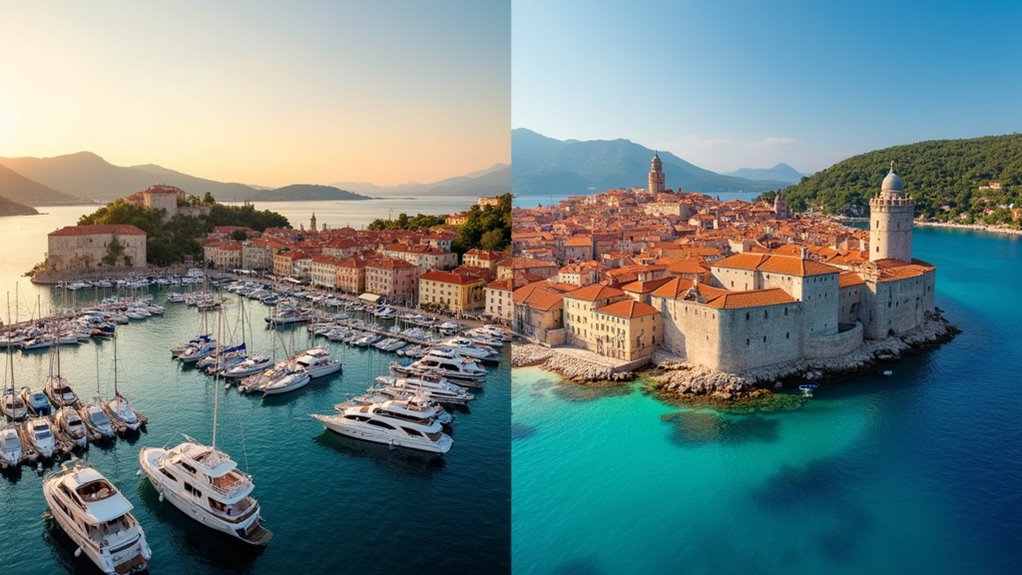
Mediterranean gems Hvar and Korčula beckons with contrasting personalities, but which island's charms will capture your heart?
Hvar offers a livelier atmosphere with upscale accommodations and vibrant nightlife, while Korčula provides a more relaxed experience with more opulent cultural heritage and family-friendly beaches. You’ll find excellent Dalmatian cuisine on both islands, but Korčula maintains more traditional flavors. Hvar connects better to Split; Korčula to Dubrovnik. Consider your priorities: Hvar for glamour and parties, Korčula for history and tranquility. Each island reveals distinct personalities beneath their Mediterranean sun.
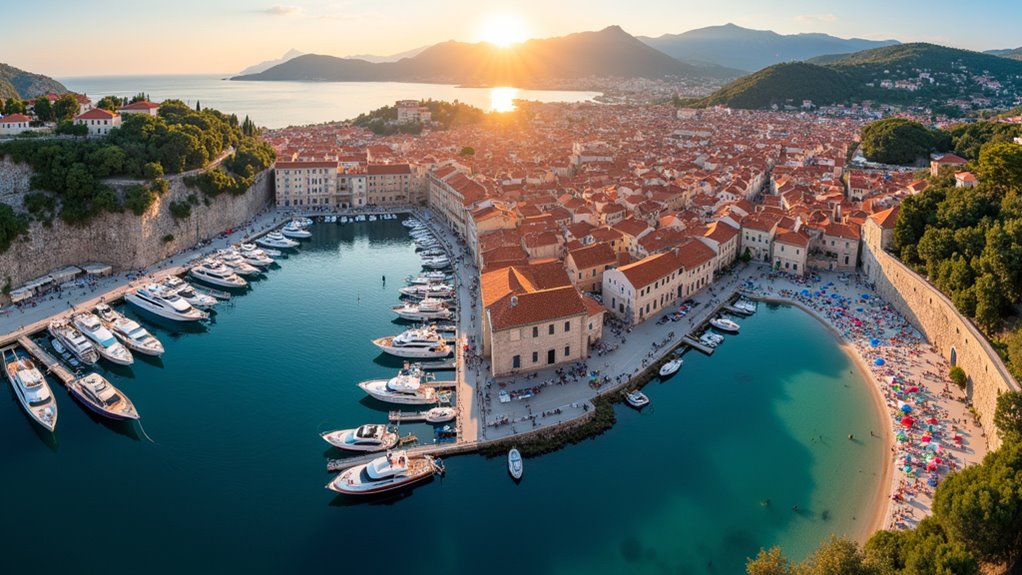
While both islands have distinct charms, Hvar and Korčula‘s visitor statistics tell a revealing story about their tourism profiles. Hvar, with its 10,700 year-round residents, transforms during peak season as it embraces its reputation as Croatia’s “elite destination.”
Hvar’s transformation from quaint island to elite hotspot reveals the stark contrast in these Adriatic gems’ tourism identities.
In contrast, Korčula’s larger permanent population of approximately 15,800 experiences a more measured tourist influx.
You’ll find Hvar particularly absent from Croatia’s top five overnight destinations (dominated by cities like Zagreb and coastal Dubrovnik), yet it attracts high-spending visitors from the 35-44 age bracket.
Korčula positions itself as a quieter alternative, drawing cultural travelers and wine enthusiasts rather than the luxury yachting crowds that flock to Hvar.
This difference means your euro stretches further on Korčula, while Hvar demands premium pricing for its UNESCO heritage sites, nightlife and exclusivity. Much like Spanish capital Madrid, Hvar caters to visitors seeking premium experiences, though the island’s concentrated tourism season creates more pronounced price variations.
Stepping onto either Hvar or Korčula means enjoying centuries of Adriatic history that’s remarkably well-preserved yet distinctly different on each island.
Korčula boasts fishbone-patterned streets designed for wind protection, the stunning St. Mark’s Cathedral, and claims Marco Polo as a native son. Don’t miss the Moreška sword dance performances, a tradition you won’t find elsewhere.
History buffs will appreciate that Korčula enacted one of Europe’s earliest slavery abolition laws in 1214.
Hvar counters with Europe’s oldest public theater (1612), the imposing Fortica Fortress, and 350-year-old UNESCO-listed agava lace traditions. The island pioneered organized tourism in 1868 and remains famous for its lavender cultivation. While sampling the local wines, be sure to try Hvar’s distinctive varieties including the indigenous Plavac Mali grapes.
Both islands share a cappella klapa singing traditions and stone masonry craftsmanship visible throughout their medieval centers. Much like the ancient ruins of Paphos archaeological site, these islands preserve their rich cultural heritage for modern visitors to explore.
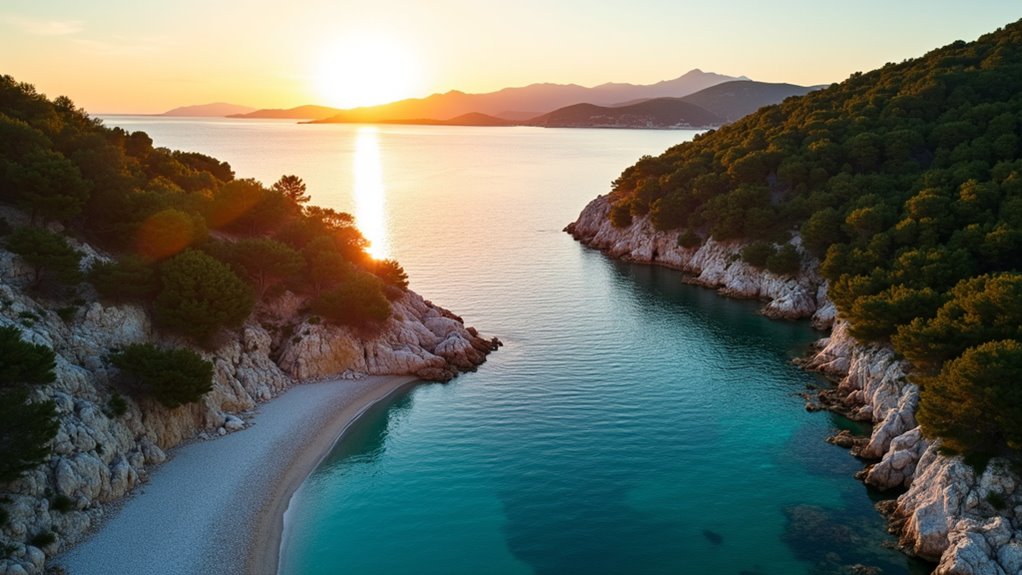
Both islands offer stunning coastal landscapes, but they present dramatically different beach experiences for travelers exploring Croatia’s Adriatic gems. On Hvar, you’ll find mostly pebbly shores with scenic bays perfect for island hopping, while Korčula boasts more diverse options including coveted sandy beaches, particularly in Lombarda.
If you’re after lavender-scented vistas, Hvar’s famous fields and elevated viewpoints won’t disappoint. The island’s accessible beaches and developed water activities make it ideal for active travelers.
Meanwhile, Korčula’s chiefly forested terrain offers a quieter communion with nature, featuring extensive woodland hiking trails and coastal scenery. The island’s Vela Pržina beach is particularly popular for families seeking sandy shores with crystal clear waters.
Budget-conscious travelers might appreciate Korčula’s more local beach experience with public transport access, while Hvar attracts those seeking livelier atmospheres. Both islands provide excellent cycling opportunities through their distinctive natural landscapes. Unlike expensive destinations such as Tenerife, these Croatian islands offer travel costs that can be quite reasonable during shoulder seasons.
When comparing accommodation options between these Adriatic islands, you’ll discover distinctly different hospitality scenes tailored to varied traveler preferences.
Hvar offers diversity—from backpacker-friendly hostels to luxury waterfront resorts, particularly concentrated in Hvar Town. You’ll pay premium prices here, especially during peak season.
Stari Grad provides more moderate alternatives. Book well in advance for budget options.
Korčula’s accommodation landscape skews toward intimate boutique hotels and private apartments housed in historic stone buildings. With limited inventory, advance reservations are essential. Families often prefer Korčula for its more laid back atmosphere, which is reflected in its family-oriented lodging options.
While generally more affordable than Hvar, Korčula’s luxury properties like Lesic Dimitri Palace rival Hvar’s upscale pricing. The island caters mainly to couples and families seeking tranquility rather than nightlife enthusiasts, with accommodations reflecting this quieter atmosphere. Both islands serve as excellent bases to explore Croatia’s charming destinations and cultural attractions beyond their shores.
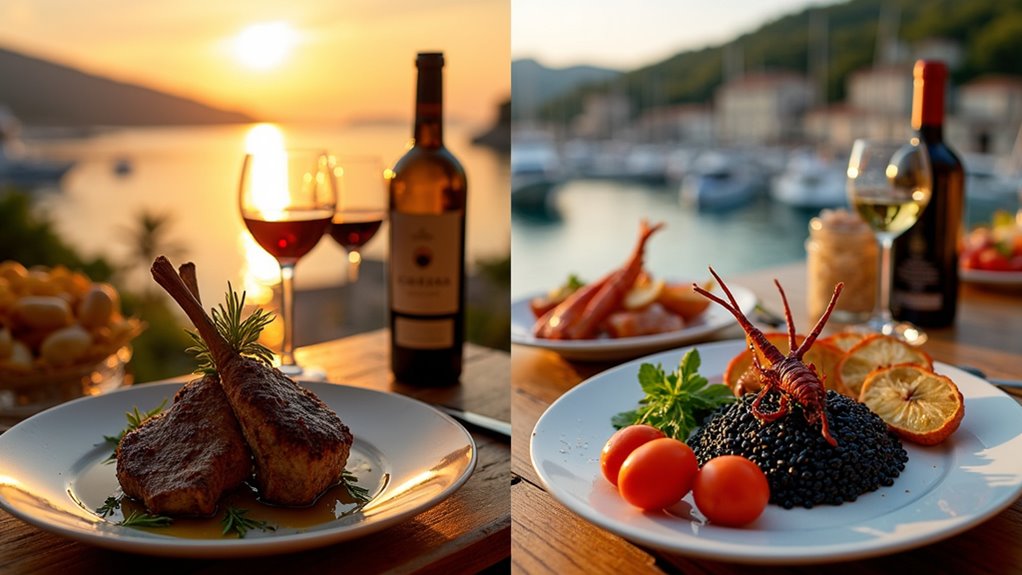
After settling into your island accommodation, your culinary journey awaits – and the gastronomic scenes on Hvar and Korčula offer distinctly different tastes of Dalmatian life.
Korčula embraces tradition with hyperlocal specialties like octopus salad and black risotto, complemented by indigenous Pošip and Grk wines. Its nine notable restaurants, including Michelin-recognized Lešić Dimitri, emphasize simple preparations and family recipes passed through generations. Wine enthusiasts particularly enjoy sampling local varietals at Bokar Wine Bar, where Croatian wines showcase impressively full flavors. Much like beginner surf spots in coastal destinations, Korčula’s culinary scene welcomes newcomers with approachable yet authentic experiences.
Hvar balances authentic dishes like gregada (white fish stew) and lavender-infused specialties with international options catering to global tastes. While both islands share the peka cooking method, Hvar’s cuisine has evolved to accommodate diverse tourist preferences.
For purists seeking traditional Dalmatian flavors and local ingredients, Korčula edges ahead. Budget-conscious travelers will appreciate both islands’ daily catch options served with local olive oil.
Getting to your island paradise can make or break your vacation experience, so understanding the transportation differences between Hvar and Korčula is essential.
Hvar boasts more frequent ferry connections from Split, while Korčula is better positioned for travelers coming from Dubrovnik.
If you’re traveling without a car, daily catamarans connect both islands in about 75-90 minutes, with tickets ranging from 40-120 HRK.
Drivers face a more complicated journey, as no direct car ferries exist between islands—you’ll need to route through the mainland, adding significant time and cost.
For those seeking convenience, private boat transfers offer a quicker alternative at around €500.
Budget travelers should plan carefully, especially during peak season when services fill quickly and prices rise.
Unlike in Istanbul where stray dogs roam freely, these Croatian islands maintain strict pet transportation regulations for ferries and catamarans.
Consider your starting point (Split or Dubrovnik) when choosing which island suits your itinerary better.
Both islands receive high accessibility ratings with Hvar scoring 9/10 for ease of reaching from major coastal cities.
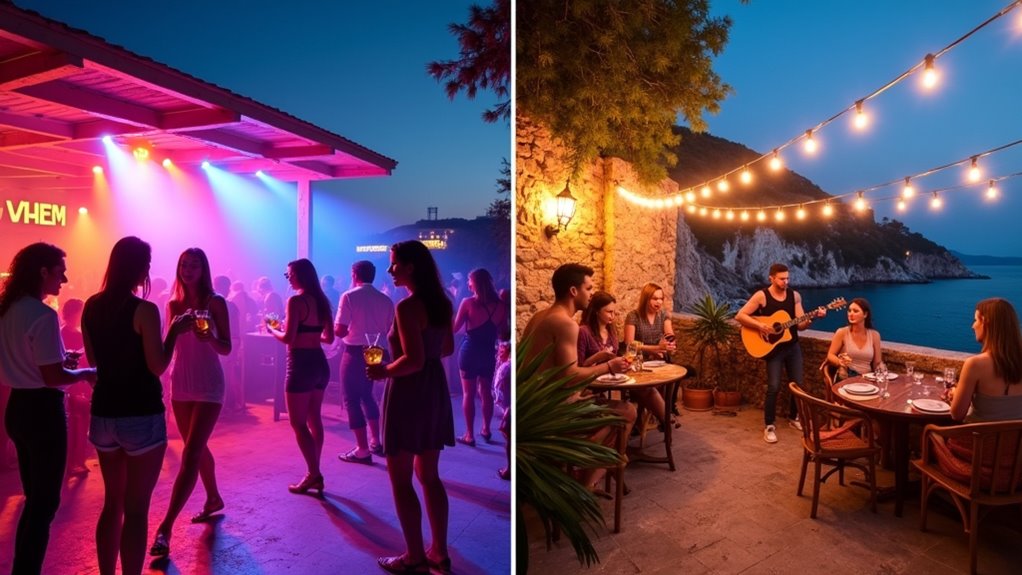
The nightlife scenes on Hvar and Korčula couldn’t be more different, offering two distinct Croatian island experiences. Hvar, often called the “Croatian Ibiza,” buzzes with clubs like Carpe Diem and Hula Hula staying open until 4AM, especially during June-September when international DJs take residence. Hvar also hosts prestigious music events like Ultra Europe festival throughout the summer season.
Expect to pay €12-15 for cocktails and potentially cover charges at exclusive venues.
Korčula offers a tranquil alternative with candlelit wine bars serving local Pošip and Grk wines for €8-10. Most establishments close by 1AM, focusing on cultural events rather than all-night parties. The atmosphere resembles what many digital nomads seek when balancing work and leisure in Mediterranean destinations.
The exception is Boogie Jungle, the island’s only proper club, located outside town.
Your choice is simple: Hvar for vibrant parties attracting 25-35 year-olds, or Korčula for relaxed, cultural evenings that appeal to mature travelers.
Both islands showcase Croatia’s outdoor paradise status, though they cater to different adventure appetites and fitness levels. Hvar emphasizes dramatic coastal experiences with Pakleni Islands kayaking, limestone cliff climbing near Sveta Nedjelja, and scenic vineyard cycling routes.
Discover Croatia’s island diversity, where Hvar’s dramatic coastal adventures meet Korčula’s gentler family-friendly explorations.
The UNESCO-listed Stari Grad Plain offers historic agricultural landscape hikes.
Korčula provides more family-friendly options with sheltered bay kayaking at Racisce, flat cycling trails in Lumbarda, and forested hikes around Pupnatska Luca.
The island’s Žrnovo area features newly developed climbing routes for various skill levels.
Both islands brilliantly blend outdoor activities with cultural experiences—try Hvar’s lavender field walks (June-July), Korčula’s wine-tasting hikes through Pošip vineyards, or cycling routes connecting olive mills. The dramatic landscape diversity from beaches to mountains creates exceptional viewpoints along many trails. Visitors will find many trails are well-marked with distances, making self-guided exploration accessible for independent adventurers.
Equipment rentals are widely available, with guided tours offering the most opulent experiences.
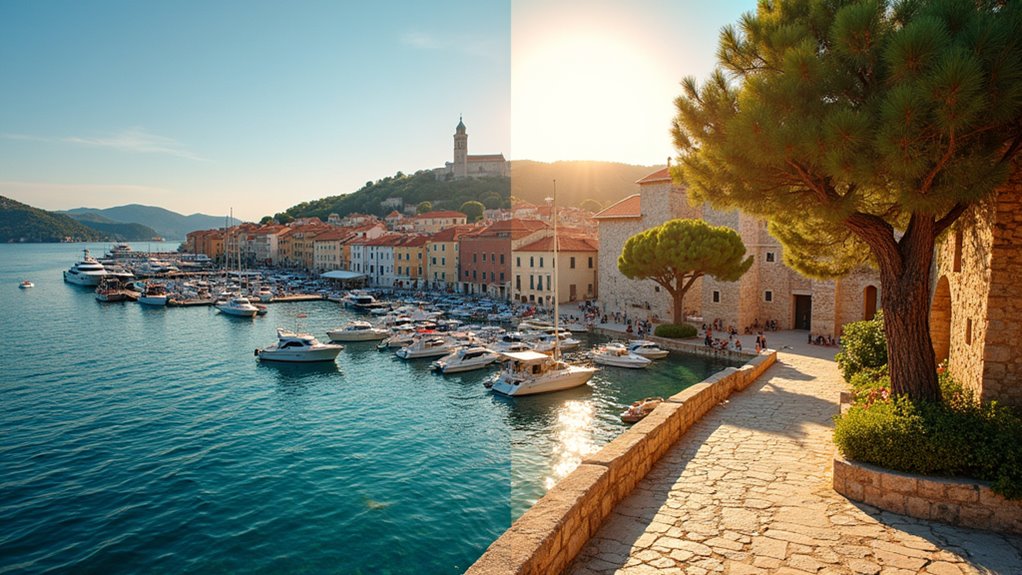
Choosing the right time to visit Croatia’s island gems depends largely on your priorities and tolerance for crowds.
Hvar shines from July to early September with 30°C temperatures perfect for beach parties and vibrant nightlife. Though August brings peak crowds and prices, visiting during this period can be lively and energetic. Hvar is among the sunniest locations in Europe, making its summer weather particularly reliable.
For better value, visit during May-June or September-October when temperatures remain pleasant (22-26°C) and the sailing is still excellent. These shoulder seasons offer a charming experience similar to exploring historic citadels like Valletta with fewer travelers.
Korčula follows similar patterns but with slightly more moderate crowds. July-August brings warmth and cultural events like the Marco Polo Festival.
Meanwhile, May-June and September-October offer ideal conditions for cycling and wine tours. October’s olive harvest adds cultural authenticity to your experience.
Both islands quiet considerably November through April. Hvar sees 22 rainy November days but offers authentic local interactions during this off-peak season.
Whether you’re drawn to Hvar’s lavender-scented hillsides or Korčula’s ancient stone walls, you’ll find your Adriatic sanctuary. Both islands stand as pearls on Croatia’s maritime crown, offering different treasures at varying prices. Visit Korčula for budget-friendly authenticity, Hvar for polished glamour. Travel off-season to avoid crowds and save markedly. The crystal waters surrounding both islands wash away distinctions—they’re simply two paths to the same Dalmatian soul.